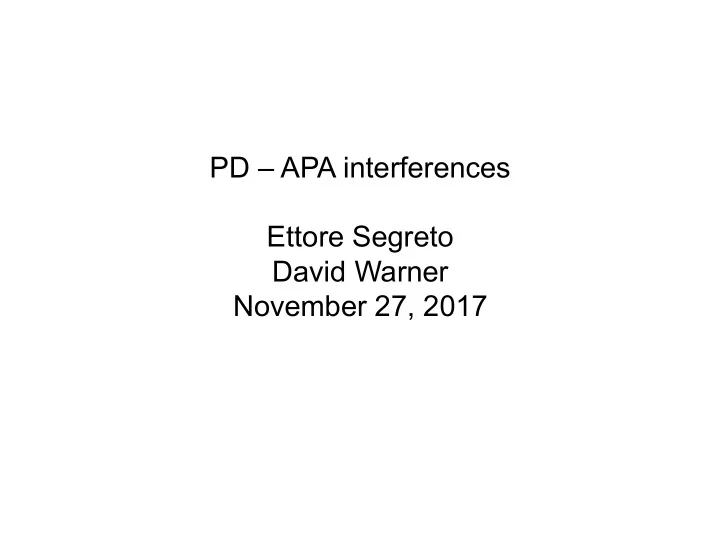

PD – APA interferences Ettore Segreto David Warner November 27, 2017
SP-PD System Description l PD system is configures in modules made of bar shaped photon collectors coupled to arrays of SiPM , which are slid between the wire planes of the APA at 10 positions along the length of the APA ü Photon collector technology not yet defined . Three available solutions: ü MIT/Fermilab light guide bars → acrylic guide bars are coated by a thin film of acrylic doped with a wavelength shifter - TetraPhenyl Butadiene (TPB). LAr scintillation light (128 nm – in the Vacuum Ultra Violet) is converted to visible (~430 nm) by the shifter and a fraction of it is guided to the extremities of the bar where it is detected by an array of SiPMs. Current (ProtoDUNE) design includes the installation of one array at one end of the bar → can be doubled to increase efficiency ü Indiana University light guide bars → Radiators plates coated by wavelength shifter (TPB) coupled to shifting/guiding bars . LAr scintillation light is converted to blue light (430 nm) by the radiator plates, shifted light enters the shifting/ guiding bars where it is down-converted to green (~480 nm) guided and detected by SiPM array(s) on one (or two) end(s) of the bar ü ARAPUCA → new concept for LAr scintillation light detection . The combination of a dichroic filter and two wavelength shifters allows light to be trapped inside a box with highly reflective internal surfaces . Trapped light is detected by a number of SiPMs installed inside the box. The actual design foresee an array of 16 ARAPUCA cells per module (bar equivalent).
proto protoDUNE design
MIT/Fermilab Module Details
Indiana University (IU) Module Details
Stainless Steel Mount Rails Insertion Slot
M5 mounting Screws to frame Rivets to rails
APA Frame Rail Drawing (Middle Rail) PD Slot Detail in APA Middle Rail
NB: ProtoDUNE Cabling Unlikely to be used in DUNE FD
Cable Exit from APA • The most constricted point of the cable routing is through the top APA top box beam • Half of the cables from the bottom APA cold electronics, as well as all Cold Electronics the PD cables (from that Cable Space side of the APA, ½ total (from lower APA) cable count), need to pass through this space • 10 kt cable count and size, as well as the connector (10 kt Detector, selection, are not ready at Top APA) this time. • We will attempt to keep the cable space required the Bottom APA same as in this model. PD Cables (Pass Thru) Screen shot of model Courtesy of Manhong Zhao, BNL
Installation Tooling Module on Installation Rail Module Just Before Final Installation
10 kt PD Design Status l Baseline PD technology decision to be taken before TDR l Alternates may still be in play at that time l Decision made on the basis of comparative measurements (protoDUNE and dedicated tests) and Monte Carlo simulations l Besides choosing the most performing device, there are important reasons to increase as much as possible the efficiency and uniformity of the light detection system: ü Meet the requirements for the detection of low energy events (supernova neutrinos and proton decay) → hard to achieve with the actual number of penetrations even if many unknown are still present (QE of the devices poorly known – measurement are in progress, MC simulation not detailed enough – great effort put in place by SP PD Consortium in this field) ü Improve the energy resolution of the detector ü 3D localization of the events with light ü Particle discrimination
PD System Requests to Improve Performance l The current (protoDUNE) design foresees the installation of 10 modules (bars) per APA through a slot 19.2mm X 108mm. l We need to explore the possibility of increasing light collection by: l increasing the dimensions of the slots l Increasing the slot width from 19.2 to 21 or 22mm would greatly improve the ease of PD installation and connector fixation strength l Increasing the slot length (from 108 to 150mm? 175mm?) directly increases the light collection at the lowest cost per photon! l Increasing the number of the slots l Increases light collection for any collector technology selected l Any increase in coverage translates directly in an increase of efficiency! l In our Consortium meetings we are discussing implementing an active veto using the LAr which lies outside the TPC . This would be very beneficial for the proton decay searches, for example. l It would imply increasing the number of slots for the external APAs and mounting a diaphragm – before wiring the APA – which separates the internal and external volumes l We also want to explore the possibility of installing reflecting foils coated with wavelength shifter on the CPA → Passively increases the light collection efficiency – Significantly improves the uniformity of light collection allowing for calorimetric measurements with light → Easy rejection of low energy background ( 39 A, alpha particles, low energy gammas )
Recommend
More recommend